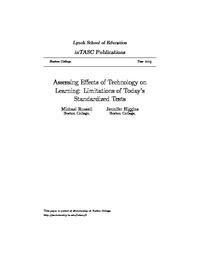Assessing Effects of Technology on LearningLimitations of Today's Standardized Tests
Michael Russell, Jennifer Higgins
Publikationsdatum:
|
 |
 Diese Seite wurde seit 6 Jahren inhaltlich nicht mehr aktualisiert.
Unter Umständen ist sie nicht mehr aktuell.
Diese Seite wurde seit 6 Jahren inhaltlich nicht mehr aktualisiert.
Unter Umständen ist sie nicht mehr aktuell.
 Zusammenfassungen
Zusammenfassungen
Over the past decade, students’ use of computers has increased sharply, particularly for writing and research (Becker, 1999; Russell, O’Brien, Bebell, & O’Dwyer, 2003). At the same time, the use of large-scale tests to make decisions about schools and students has exploded. But, in addition to making decisions about students and their schools, results from large-scale tests are also used to assess the impact of computer-based technology on student learning. As one example, Wenglinsky (1998) used test scores from the National Assessment of Educational Progress (NAEP) mathematics test to examine the relationship between computer use during mathematics instruction and mathematics achievement.
Clearly, the use of standardized test scores to assess the effects of technology is attractive for at least two reasons. First, the public and political leaders tend to accept standardize tests as valid and reliable measures of student achievement. Second, these tests provide a common measure across large numbers of students. Yet, despite these advantages, using test scores from standardized tests to assess the impact of technology on student learning can be problematic.
Von Michael Russell, Jennifer Higgins im Text Assessing Effects of Technology on Learning (2003) Clearly, the use of standardized test scores to assess the effects of technology is attractive for at least two reasons. First, the public and political leaders tend to accept standardize tests as valid and reliable measures of student achievement. Second, these tests provide a common measure across large numbers of students. Yet, despite these advantages, using test scores from standardized tests to assess the impact of technology on student learning can be problematic.
 Dieser Text erwähnt ...
Dieser Text erwähnt ...
 Personen KB IB clear | Harold Wenglinsky | ||||||||||||||||||
 Fragen KB IB clear | Was bringt Computereinsatz in der Schule? | ||||||||||||||||||
 Begriffe KB IB clear |  Problemlösefähigkeit Problemlösefähigkeit problem solving skills problem solving skills
| ||||||||||||||||||
 Texte |
|
 Zitationsgraph
Zitationsgraph
 Zitationsgraph (Beta-Test mit vis.js)
Zitationsgraph (Beta-Test mit vis.js)
 1 Erwähnungen
1 Erwähnungen 
- Ubiquitous Computing in K-12 Classrooms - A Systematic Review (Edward C. Bethel, Robert M. Bernard, Philip C. Abrami, Anne C. Wade) (2008)

 Volltext dieses Dokuments
Volltext dieses Dokuments
 |  Assessing Effects of Technology on Learning: Artikel als Volltext ( Assessing Effects of Technology on Learning: Artikel als Volltext ( : :  , 152 kByte; , 152 kByte;  : :  Link unterbrochen? Letzte Überprüfung: 2020-11-28 Letzte erfolgreiche Überprüfung: 2019-01-28) Link unterbrochen? Letzte Überprüfung: 2020-11-28 Letzte erfolgreiche Überprüfung: 2019-01-28) |
 Anderswo suchen
Anderswo suchen 
 Beat und dieser Text
Beat und dieser Text
Beat hat Dieser Text während seiner Zeit am Institut für Medien und Schule (IMS) ins Biblionetz aufgenommen. Beat besitzt kein physisches, aber ein digitales Exemplar. Eine digitale Version ist auf dem Internet verfügbar (s.o.). Aufgrund der wenigen Einträge im Biblionetz scheint er es nicht wirklich gelesen zu haben. Es gibt bisher auch nur wenige Objekte im Biblionetz, die dieses Werk zitieren.








 Biblionetz-History
Biblionetz-History